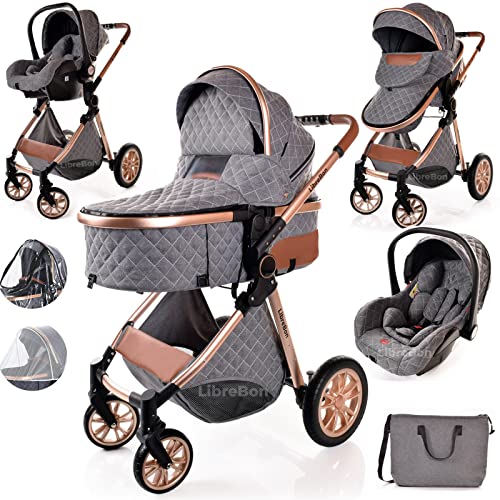Understanding Prams and Pushchairs: A Comprehensive Guide
When getting in the world of parenthood, one of the most essential decisions to make includes picking the right devices for carrying a newborn or young child. Amongst the top contenders for this function are prams and pushchairs. Both serve the fundamental function of helping moms and dads and caretakers bring their kids easily, but they have unique functions, advantages, and utilize cases that set them apart. This short article aims to explore prams and pushchairs thorough, directing prospective buyers through their important differences, advantages, and functions, and addressing frequently asked concerns.
What is a Pram?
A pram, brief for "perambulator," is a type of car developed specifically for babies. It includes a fully reclining seat or bassinet, so a baby can lie flat while being carried. This is especially important for newborns whose spinal columns are still developing. Prams often have bigger wheels, offering a smoother trip on numerous surfaces.
Key Features of Prams:
- Fully Reclining Seat: Allowing babies to lie flat.
- Bassinet Design: Some models come with a removable bassinet.
- Large Interior: Adequate space for the kid to move comfortably.
- Robust Frame: Designed to be more steady, preferably fit for metropolitan and rural areas.
Advantages of Prams:
- Comfort: Provide a relaxing area for the baby.
- Adaptability: Many can be converted to a pushchair as the kid grows.
- Stability: Larger wheels and frames provide greater stability, specifically on uneven surface.
What is a Pushchair?
A pushchair is a lightweight alternative typically used for toddlers. Unlike prams, pushchairs generally feature a seat that can sit upright and might not provide a completely reclining option, making them appropriate for older babies who can support their heads and necks. The majority of modern-day pushchairs come with various functions geared towards convenience for the parent and convenience for the kid.
Key Features of Pushchairs:
- Multi-position Seats: Can accommodate sitting upright or reclining options.
- Lightweight Design: Easier to carry and steer.
- Foldable Framework: Often fold compactly for simple storage and transport.
- Larger Storage Baskets: Convenient for bring baby fundamentals.
Benefits of Pushchairs:
- Lightweight and Portability: Easy to carry and save.
- Steerability: Smaller wheels enable sharper turns.
- Availability: Easier access to older toddlers.
Key Differences Between Prams and Pushchairs
| Function | Pram | Pushchair |
|---|---|---|
| Age Recommendation | Newborn to 6 months | 6 months to 4 years |
| Seat Position | Fully reclined | Multi-position |
| Weight | Much heavier | Light-weight |
| Terrain Usage | Suitable for all terrains | Best for city/urban environments |
| Size | Larger, bulkier | Compact, simple to fold |
Choosing the Right Option for Your Needs
The choice to choose between a pram and a pushchair mainly depends upon your particular lifestyle and your kid's age. Here is a breakdown of considerations to assist narrow down the alternatives:
Considerations for Prams:
- If you reside in a backwoods with rough terrain, a strong pram may be preferable.
- If you plan to use it for long walks or getaways, the comfort of a pram can be beneficial.
- Suitable for parents who want a design that will conveniently support a newborn.
Factors to consider for Pushchairs:
- If you need something lightweight for city living or public transport, a pushchair might be a better fit.
- For parents who want a versatile alternative for young children with various position settings.
- If storage space is a concern, the compact nature of pushchairs provides a solution.
Common FAQs
1. Can you use a pushchair for a newborn?
While lots of modern pushchairs offer reclining seats that can be utilized for newborns, it's typically advised to utilize a pram or a pushchair with a bassinet alternative for sufficient assistance.
2. How long can Prams Pushchairs UK utilize a pram or a pushchair?
Prams are typically used for babies as much as six months, while pushchairs can be ideal for children as much as 4 years or more, depending upon the design.
3. Are prams more costly than pushchairs?
Prams are often pricier due to their design, flexibility, and products. However, expenses can vary commonly depending on brand, functions, and age recommendations.
4. Is it essential to have both a pram and a pushchair?
Not always. Many parents go with a 2-in-1 system that combines both functions, permitting them to adjust as their kid grows.
5. What should I focus on in choosing one?
Focus on safety functions, comfort, weight, size, and how well it suits your lifestyle. Read evaluations, and test drive different models when possible.
Selecting between a pram and a pushchair is a crucial choice for new moms and dads and caregivers. Both choices have unique features that deal with different age ranges and lifestyles. By comprehending these important differences, advantages, and recommendations, moms and dads can make a more informed option that meets their household's requirements. Whether starting a leisurely stroll in the park or navigating the pressure of city streets, the right pram or pushchair can boost the experience, supplying safety and comfort for both the child and the caregiver.

